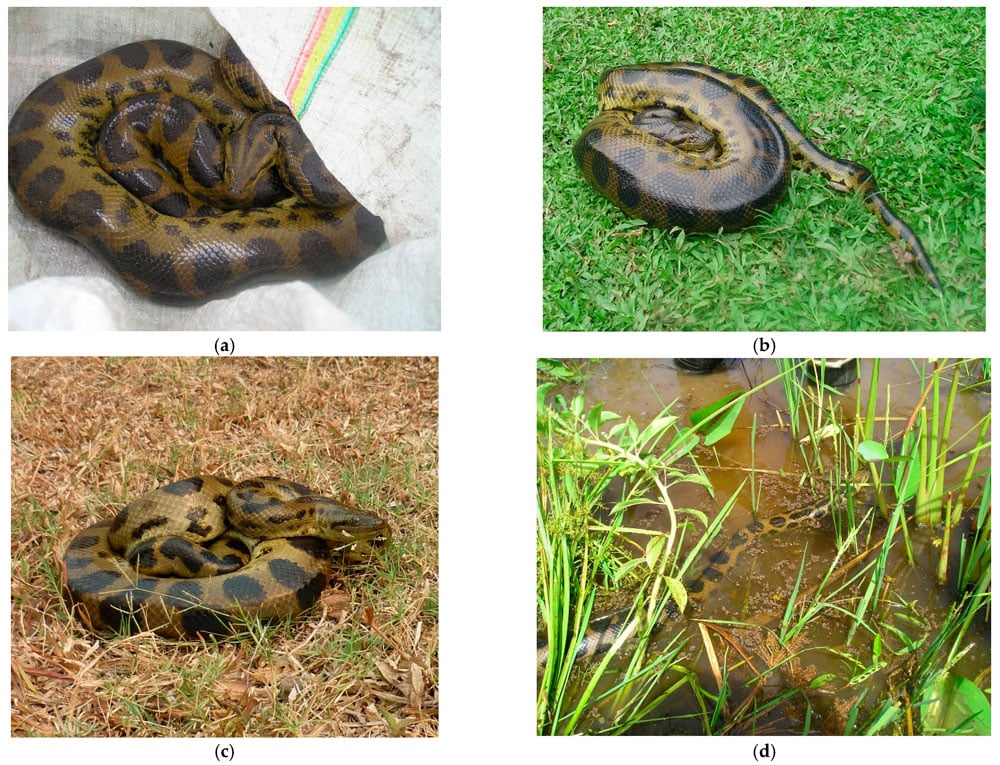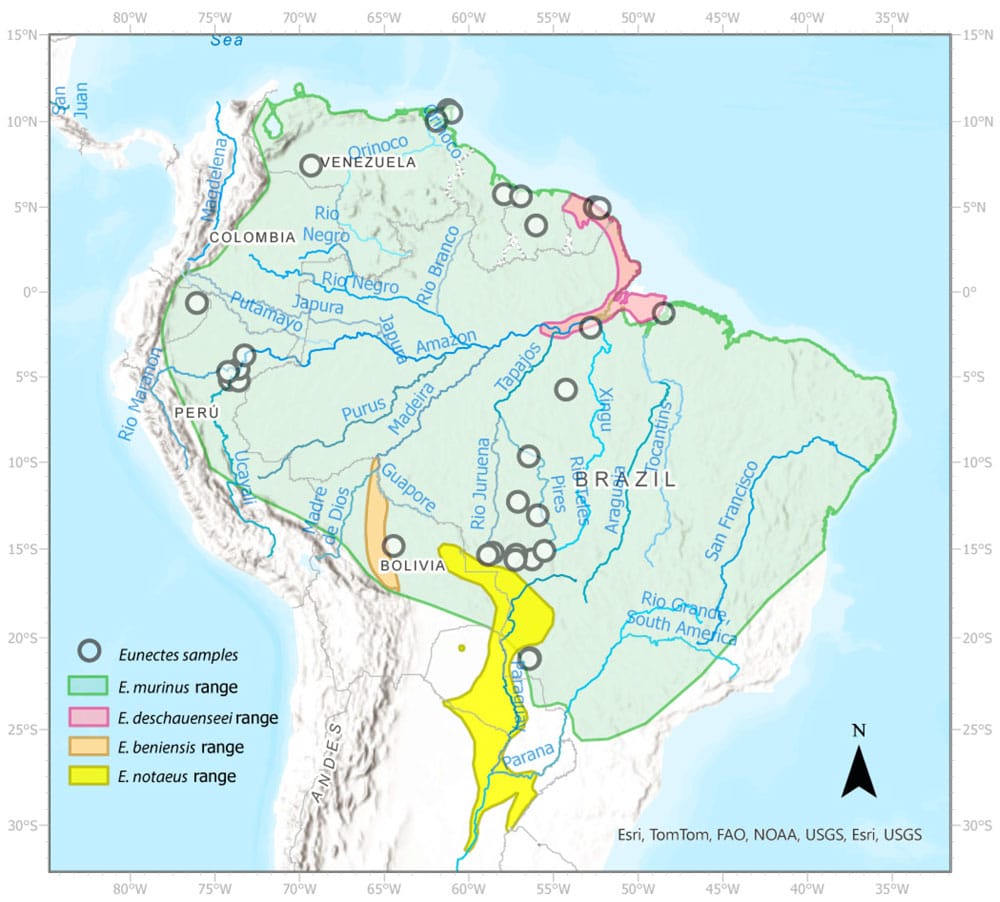After extensive research and analysis of genetic data from four known anaconda species, scientists have concluded that the Northern green anaconda (Eunectes akayima sp. nov) is a distinct species from the Southern green anaconda (E. murinus). They have also proposed the unification of Eunectes deschauenseei and Eunectes beniensis with Eunectes notaeus, creating a single species based on genetic and phylogeographic analyses.
The newly identified Northern green anaconda (Eunectes akayima sp. nov) is believed to inhabit Ecuador, Colombia, Venezuela, Trinidad, Guyana, Suriname, and French Guiana. The dark spotted anaconda (Eunectes deschauenseei) has a wider range, from the Amazon River delta in Brazil to French Guiana.

(a) E. deschauenseei caught in Beni, Bolivia (B54). (b,c) Anacondas caught in Beni that had markings of E. deschauenseei but were identified as E. beniensis in the phylogenetic analysis (B52 and B58). (d) E. beniensis identified as E. beniensis in the phylogenetic analysis. Photo by (a) E. deschauenseei caught in Beni, Bolivia (B54). (b,c) Anacondas caught in Beni that had markings of E. deschauenseei but were identified as E. beniensis in the phylogenetic analysis (B52 and B58). (d) E. beniensis identified as E. beniensis in the phylogenetic analysis. Photo by (a) E. deschauenseei caught in Beni, Bolivia (B54). (b,c) Anacondas caught in Beni that had markings of E. deschauenseei but were identified as E. beniensis in the phylogenetic analysis (B52 and B58). (d) E. beniensis identified as E. beniensis in the phylogenetic analysis. Photo by Jesus A. Rivas et.al.
The researchers also suggest that the Northern green anaconda may also be found in Suriname. The yellow anaconda (Eunectes notaeus) can be found in the Pantanal, Chaco, as well as in Brazil, Bolivia, Paraguay, Argentina, and Uruguay. The green anaconda (E. murinus) is distributed throughout much of South America and Trinidad Island in the Caribbean. The researchers note in their paper that there is a significant overlap between E. deschauenseei and E. beniensis, as well as with E. murinus.
The research was conducted over a period of 20 years, with significant progress made during a 2022 expedition in the Ecuadorian Amazon. The trip was made possible through an invitation from Warrant chief Penti Baihuam, who leads the Baihuaeri Warrant territory in Ecuador’s Bambino region. Actor Will Smith also joined the expedition as part of a National Geographic series he was filming. The researchers collected data, including tissue and blood samples from each specimen, as well as information on habitat type and location. This data confirmed the existence of two distinct species of green anaconda. The two species may look almost identical, but they have a 5.5% genetic divergence.

Sampling location of samples used in this study. The green area represents the known distribution of the Green Anaconda (Eunectes murinus). The yellow area represents the distribution of the Yellow Anaconda (E. notaeus). The orange area represents the reported distribution of E. beniensis, and the red area represents the distribution of E. deschauenseei. Map via USGS
In addition to describing the new species, the researchers also propose a phylogeographic hypothesis that examines the diversification of anacondas in western South America during the Miocene.
The full paper, “Disentangling the Anacondas: Revealing a New Green Species and Rethinking Yellows,” can be read in the open access journal Diversity.
Facts About Green Anacondas
Anacondas are non-venomous constrictors that are among the largest snake species in the world, reaching lengths of over 17 feet and weights exceeding 150 pounds. One notable characteristic of these snakes is their eyes, which are positioned on top of their head, allowing them to see above the water with just their head exposed.
Golden Dorado Follows Green Anaconda in Potential Nuclear-Follower Feeding Association
Conserving the Green Anaconda
This snake is perhaps one of the most widely mythologized of the large constrictors, due in part to old television shows and movies that depicted them as massive, monstrous reptiles that devour anything that moves. They have been falsely reported to be the largest snakes in the world. In the Americas, they are the largest, unless you count the invasive Burmese pythons of the Florida Everglades.
.fb-background-color {
background: #ffffff !important;
}
.fb_iframe_widget_fluid_desktop iframe {
width: 100% !important;
}
The post New Green Anaconda Species Discovered appeared first on Reptiles Magazine.


Wow, that’s incredible! I wonder what other amazing creatures are yet to be discovered in Brazil.